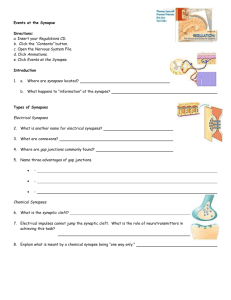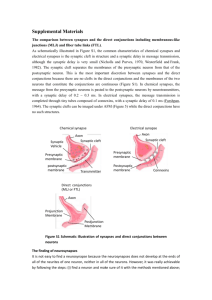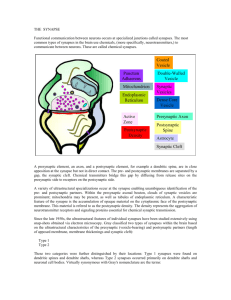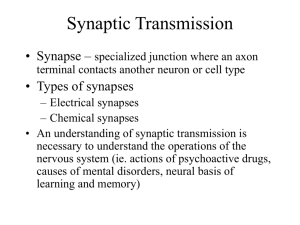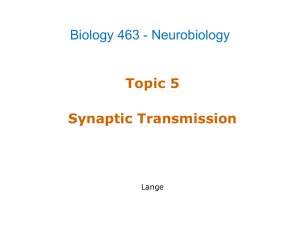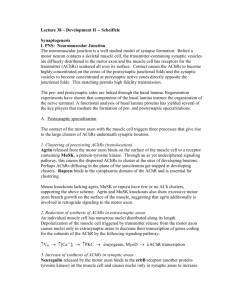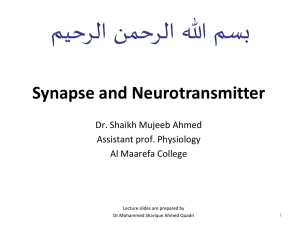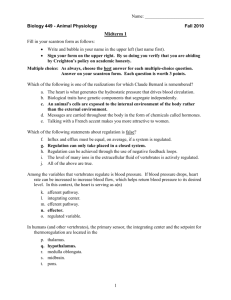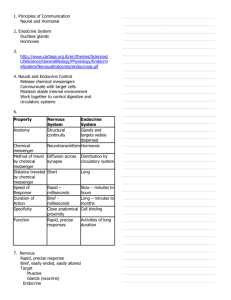Handout synapse
advertisement
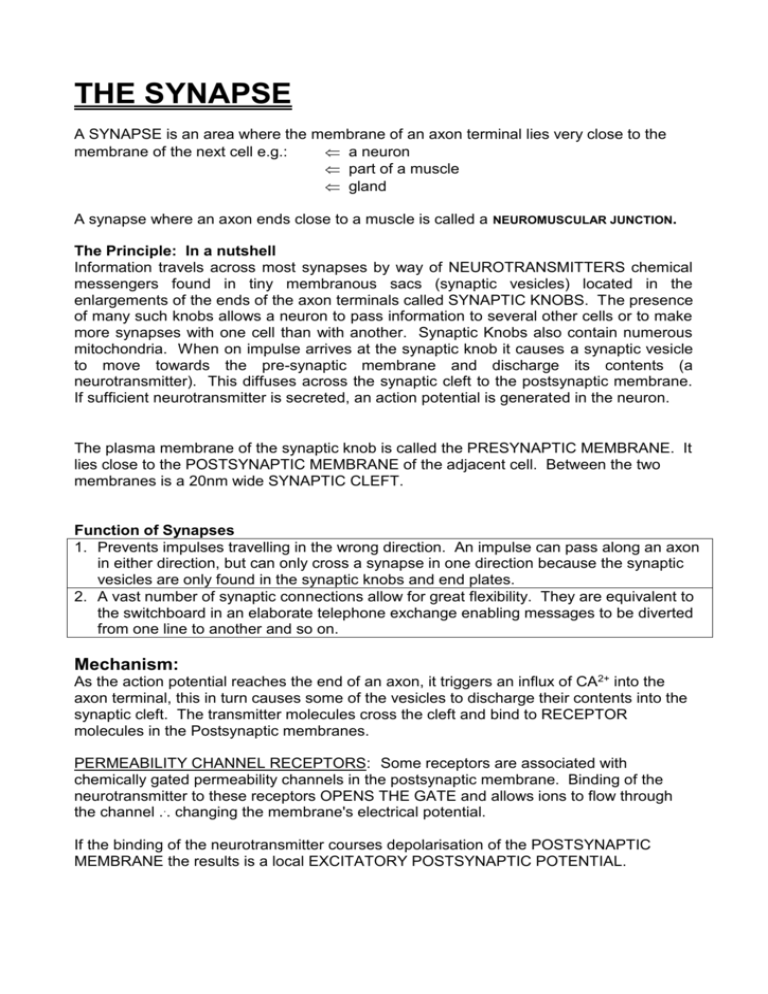
THE SYNAPSE A SYNAPSE is an area where the membrane of an axon terminal lies very close to the membrane of the next cell e.g.: a neuron part of a muscle gland A synapse where an axon ends close to a muscle is called a NEUROMUSCULAR JUNCTION. The Principle: In a nutshell Information travels across most synapses by way of NEUROTRANSMITTERS chemical messengers found in tiny membranous sacs (synaptic vesicles) located in the enlargements of the ends of the axon terminals called SYNAPTIC KNOBS. The presence of many such knobs allows a neuron to pass information to several other cells or to make more synapses with one cell than with another. Synaptic Knobs also contain numerous mitochondria. When on impulse arrives at the synaptic knob it causes a synaptic vesicle to move towards the pre-synaptic membrane and discharge its contents (a neurotransmitter). This diffuses across the synaptic cleft to the postsynaptic membrane. If sufficient neurotransmitter is secreted, an action potential is generated in the neuron. The plasma membrane of the synaptic knob is called the PRESYNAPTIC MEMBRANE. It lies close to the POSTSYNAPTIC MEMBRANE of the adjacent cell. Between the two membranes is a 20nm wide SYNAPTIC CLEFT. Function of Synapses 1. Prevents impulses travelling in the wrong direction. An impulse can pass along an axon in either direction, but can only cross a synapse in one direction because the synaptic vesicles are only found in the synaptic knobs and end plates. 2. A vast number of synaptic connections allow for great flexibility. They are equivalent to the switchboard in an elaborate telephone exchange enabling messages to be diverted from one line to another and so on. Mechanism: As the action potential reaches the end of an axon, it triggers an influx of CA2+ into the axon terminal, this in turn causes some of the vesicles to discharge their contents into the synaptic cleft. The transmitter molecules cross the cleft and bind to RECEPTOR molecules in the Postsynaptic membranes. PERMEABILITY CHANNEL RECEPTORS: Some receptors are associated with chemically gated permeability channels in the postsynaptic membrane. Binding of the neurotransmitter to these receptors OPENS THE GATE and allows ions to flow through the channel ... changing the membrane's electrical potential. If the binding of the neurotransmitter courses depolarisation of the POSTSYNAPTIC MEMBRANE the results is a local EXCITATORY POSTSYNAPTIC POTENTIAL. NB Only if the postsynaptic cell is depolarised enough to EXCEED ITS OWN AXON's THRESHOLD will it transmit an action potential down its axon to another synapse. (Often a postsynaptic cell will not fire an ACTION POTENTIAL if it received information from only ONE presynaptic cell). INHIBITORY SYNAPSES: Not all synapses are excitatory. Sometimes the binding of transmitter molecules may cause the postsynaptic membrane to become HYPERPOLARISED or alternatively become more permeable to Ca 2+. i.e. the transmitter molecules decrease the activity of the next cell After they have acted, transmitter molecules must be removed or destroyed. Otherwise, their action would continue indefinitely and all information would be lost. e.g. ACETYLCHOLINE is broken down by the enzyme ACETYLCHOLINESTERASE Many insecticides & nerve gases (e.g. organophosphates) INHIBIT acetylcholinesterase. In the presence of such inhibitors acetylcholine keeps stimulating the postsynaptic membranes and the nervous system soon goes wild, causing contraction of the muscles in uncontrollable spasms and eventually death. NOR-ADRENALINE This is another transmitter substance which may be in some synapses instead of Acetylcholine, e.g. some human brain synapses & sympathetic nervous system synapses. Synapses result in an appreciable delay, up to one millisec. Therefore slows down transmission in nervous system. Synapses are highly susceptible to drugs and fatigue e.g.:1 Curare (poison used by S.American Indians) and atropine stops Acetylcholine from depolarising the post-synaptic membrane , i.e. become paralysed. 2 Strychnine and some nerve gases inhibit or destroy acetylcholinesterase formation. Prolongs and enhances any stimulus, i.e. leads to convulsions, contraction of muscles upon the slightest stimulus. 3 Cocaine, morphine, alcohol, ether and chloroform anaesthetise nerve fibres. 4 Mescaline and LSD produce their hallucinatory effect by interfering with nor-adrenaline. Synapses where acetylecholine is the neurotransmitter = cholinergic synapses Synapses where noradreneline is the neurotransmitter = adrenergic synapses

